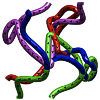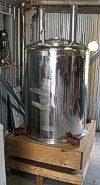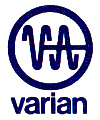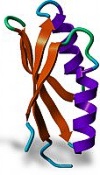September 30, 2009

Key info:
a) Very close:
(4,19), (5,18)
(6,42), (7,42)
b) Close:
(4,18), (5,19)
(7,41), (8,41)
(12,29), (13,28)
Trivial info
a) Very close:
(n-1,n), (n,n+1)
b) Close:
(n-1,n+1)
| Protein structure and scalar relaxation
A couple of months ago I have received this query from a person who signed as Lasalle:
Dear Stan, I have one small question:
Off course in proteins the CSA and dipolar relaxation are the main cause for relaxation.
Anyhow if one would do a "Gedankenexperiment" (a theoretical experimental setup) and assume that scalar relaxation of the first or second kind are possible than the distance calculation by NOE measurements should be error-prone.
Thus do you know any good article, that tells us how big the error in NOE distance calculation would be if scalar relaxation plays a role?
Right there, I have prepared the following answer:
Dear Lasalle, sincerely, this is not really my field and no, I do not know about any specific text.
On the other hand, I do not see why you call this a "Gedankenexperiment" (though I love your definition of the term). Scalar relaxation certainly exists and is present. The problem (or the good luck, if you wish) is that its effects are negligible.
One can relatively easily make a rough estimate of the contribution of scalar relaxation to NOE in organic molecules like proteins. Considering the magnitudes of typical 2J, 3J and 4J proton-proton couplings (or better the magnitudes of their variable parts) and the respective typical mean distances of such proton pairs, scalar interaction comes out far two small compared with typical
magnitudes of the dipole-dipole interactions to play any meaningful role.
Moreover, for nuclei that are structurally far away from each other, scalar relaxation is of course completely out of question, while the dipolar relaxation may be still effective, provided the nuclei are sterically close (below 0.5 nm).
Such pairs of nuclei are by far the most important ones for defining the overall shape of the protein molecule and it is actually NOT very important what is the exact computed value of the internuclear distance. Due to internal molecular motions and to the steep inverse 6th-order dependence of NOE on the internuclear distance, the measured distances are anyway just averages over some very broad distributions.
I have overheard experts arguing whether a pure yes/no indication about the presence of a NOE crosspeak is not all the info one needs. Most tend to distinguish three ranges of distances: up to 0.25 nm (bonded), 0.25 - 0.5 nm (close) and more than 0.5 nm (far).
Under these circumstances, it is clear that scalar relaxation can not affect the protein steric structure results at all. Which may be why you can not find any article about its effects - people are not very eager to publish papers with negative conclusions.
Cheers, Stan
But, not being any protein expert, I had some doubts about whether I was not overdoing it. To double check, I wrote to Chris Spronk (Spronk NMR Consultancy) and he added a few important additional insights:
Hi Stan, I am not an expert in relaxation myself, but your mail seems to make perfect sense. NOE based distance calculations are inaccurate for a variety of reasons, not in the least because of spin-diffusion that normally is present. Some groups do complete relaxation matrix analysis to take spin diffusion into account; in rare cases people do even complete NOE build-up curves to measure the spin diffusion. However, this is impractical and most people don't bother. Especially now that 3D (15N/13C) noesy's are normally used, for which there is another factor of influence on the NOE peak volume: the pathway going through the heteronucleus. Moreover, the intra-residual NOEs, which would be influenced by the scalar coupling contribution, have no effect on the structure whatsoever (just maybe if they could be obtained at very high precision, but it is exactly these close protons that suffer the most from spin-diffusion, and thus are very inaccurate). Have a look at this page.
What is important for a structure is to obtain good quality and informative NOE based distance restraints, which are usually all medium and long range. The exact distances thereof are of lesser importance, as long as the distance range is set appropriately.
Another thing worth mentioning: in the latest methods (ISD) distances are not even derived directly anymore from NOE intensities, but their distributions are calculated using Bayesian statistics.
Sorry for the long answer :), Cheers, Chris
Humbled a bit by this expert comment, but pleased that at least I was not completely off the point, I did two things:
First, I wrote a brief primer on scalar relaxation with a physicist's kind of introduction. It contains no math but otherwise it is quite serious (I hope) and possibly plugs a minor hole in the internet coverage of NMR relaxation.
Second, I thought up a simple situation which illustrates (see the column on the left) why we say that to determine the shape of a protein molecule we have to measure distances - and at the same time we assert that those same distances do not need to be accurate!
Think about it in terms of a housing development project winding around a hill (the black line is a road and the red circles are houses). Now, in order to know the overall plan of the project, is it important to know the exact distances between adjacent houses? Obviously, not at all. The key information is that certain houses with quite distant numbers (structural distance) are actually quite close to each other (steric proximity). And even this info does not need to be precise - the fact that they are [very or moderately] close is all that is needed.
So, Lasalle, should you use, so to say, sophisticated laser distance meters with sub-micron precision and a team of surveyors just to determine the overall shape of the housing project, you might be loosing your time and money. Pacing it out yourself is quite sufficient.
|
September 13, 2009

| Spin phase states and magnetic pseudo-monopoles
Science media are abuzz these days with news about the discovery of magnetic monopoles, even though most of the articles correctly point out that what has been really discovered are no real monopoles but a kind of distant look-alike's which form under certain conditions in particular solid state substances known as spin ices.
Several readers have asked me what I thought about it. I can sum up my own thoughts about this particular discovery, but be warned: they are personal guesses which do not necessarily match what many of those working in the field have written ...
Imagine a long, wormlike solenoid (something like a meter long and very flexible metal spring with just 5 mm diameter) and suppose there is an electric current flowing through it. This creates a magnetic field around the object which is essentially cylindrical everywhere except at the ends where it assumes approximately spherical configuration. Now imagine that you have a handy Magnetic Field Sniffer (MFS) and release it on this object. It will immediately detect the ends where the field gradients are strongest and most extensive and, a bit later, it will find also the weaker tube which connects the end points. You could then try and confuse the MFS: for example, you could make the solenoid worm still longer and pack it randomly into a bundle. The MFS would then perceive only a weak magnetic "noise" inside the bundle and close to it, but the two ends would still be easily detectable, no matter where they are. Likewise, should the mid sections of the worm wriggle and vibrate, the magnetic field in those areas would get smeared and the MFS (assuming it is a bit sluggish) would again see clearly just the ends. In such situations, if the MFS were intelligent enough to answer questions and you asked it what it sees, it would say "two monopoles".
I believe that what has been observed is something of the same kind. In a crystal containing strongly interacting spins our 'wormlike solenoids' become long strings of head-to-tail oriented spins (nothing in common with the "strings" of the string theory which some theoretical physicists cherish). In principle, the spins do not have to move physically, they just need to orient their spin vectors so as to form the magnetic strings. But it apparently helps a lot when there is also an extra degree of mechanical freedom, provided it does not involve any energy (this is the case of spin ices). Moreover, since a crystal has three dimensions, there are many ways how to arrange such a string between any two end-points. Which means that the spin string connecting the end-points can keep jumping between the individual paths, or even get distributed over all of them in a quantum manner. Whichever is the case, the effect is to smear-out its middle sections, leaving just the ends clearly visible to an instrument (MFS) - and to each other. Moreover, the great adaptability of the strings makes it possible for the ends to move around in a particle-like fashion.
It reminds me vaguely of the linear micellae that form in some apparently simple ternary solutions (like water+cyclohexane+lecithin). As my friends at University of Bari (Gerardo Palazzo, Andrea Ceglie and Giuseppe Colafemmina) taught me, within very precise regions of the composition diagram - and in a very precise temperature range - these solutions produce wormlike tubular micellae a few nanometers across but tens of thousands of kilometers long. This is part of the dazzling complexities of molecular aggregation when inter-molecular interaction energies start to be comparable to those of thermal motions.
In electron spin systems, the spin-interaction energies are considerably smaller than inter-molecular energies in bulk matter. Typically, one degree Kelvin in electron spintronics corresponds to several hundred degrees in molecular physics, a temperature range where we find substances in all kinds of aggregation phases (gases, liquids, solids, liquid crystals, micellae, ...). Likewise, there is no reason why at temperatures between 0.1 and 10 K we should not have all kinds of electron spin phases, with all that comes with such a concept (spin phase equilibria, state diagrams and transitions, etc.). Ferromagnetic and anti-ferromagnetic systems constitute examples of 'solid' spin phases, while plain paramagnetics could be classified as 'gaseous'. And now it turns out that in some special systems and within precise temperature bounds, we also have a spin phase composed of spin strings which to some sensors look like a gas made of magnetic monopoles.
The thermodynamic conditions under which the spin strings might be sufficiently stable are probably very stringent. One fails to see why the opposite heads of each string should not join to form closed spin loops (a new spin phase?). Unless, however, we envision a kind of spin spaghetti where the heads keep pairing with whatever counterpart they can find and the spaghetti keep breaking randomly, giving rise to a stationary dynamic-equilibrium chaos.
If you wonder whether the same things could happen in nuclear spin systems, the answer is yes, but at nearly half a million times lower temperatures (roughly the square of 658, the ratio of the electron and proton γ factors). Since practical micro-Kelvin physics is yet to come, we need to wait a bit more before we see a re-edition of similar phenomena in a nuclear spin format. However, unpaired electrons often react quite strongly with magnetic moments of the nuclei present in the material and these interactions are likely to affect the onset and the properties of the collective electron-spin states we are discussing.
The question now is: can such fancy collective electron-spin states be detected and studied by Magnetic Resonance? Personally, I don't see why not. In fact, if I were to study these phenomena, ESR and NMR would be my prime choices because the effects of the formation of any collective electron-spin state on the spectra should be remarkable. I read that at present they are using primarily neutron scattering which is a fine technique, but I would expect MR to be more informative.
Some references and links:
- Morris D.J.P., Tennant D.A., Grigera S.A., Klemke B., Castelnovo C., Moessner R., Czter-Nasty C., Meissner M., Rule K.C., Hoffmann J.-U., Kiefer K., Gerischer S., Slobinsky D., Perry R.S.,
Dirac Strings and Magnetic Monopoles in Spin Ice Dy2Ti2O7,
Science, 3 September 2009: 1178868v1.
DOI link
- Moessner R., Schiffer P.,
Magnetism: Monopoles on the move,
Nature Physics 5, 250-251 (2009).
DOI link
- Castelnovo C., Moessner R., Sondhi S.L.,
Magnetic monopoles in spin ice,
Nature 451, 42-45 (2008).
DOI link
-
Novel Material May Demonstrate Long-sought 'Liquid' Magnetic State,
Science Daily, September 9, 2005.
- Palazzo G. et al,
Structure, Dynamics, and Phase Behavior of Lecithin-Based Microemulsions,
Presentation at the ECI conference ASSOCIATIONS IN SOLUTION: FUNCTION, PERFORMANCE, AND SYNTHESIS
(July 22-26 2007 Barga, Italy)
- Shchipunov Yu.A.,
Lecithin organogel: A micellar system with unique properties,
Colloids and Surfaces A: Physicochemical and Engineering Aspects 183-185, 541-554 (2001).
DOI link
|
September 6, 2009
Newborn ideas
(a fitting poem)
| PERFIDI and other Magnetic Resonance patents
This entry is a bit personal, but I will try to extend its scope. The personal part regards the fact that I have discontinued the web site www.perfidi.net. Though the URL will remain valid until July 2010, it contains just a redirect to the PERFIDI section of this site where I have moved all the original content. PERFIDI (Parametrically Enabled Relaxation Filters with Double and multiple Inversion) is a pulse sequence preamble which I and my friend Paola Fantazzini have patented four years ago through the services of University of Bologna (presently the owner of the patent).
Which brings me to the topic of patenting in general and patenting NMR/MRI hardware, pulse sequences, and software in particular.
Regarding the general aspects, there is presently a lively discussion about whether patents are still worth a dime. It seems that only industries dealing with farmaceuticals and cosmetics find patenting important. It used to be also genetics, but there are now second thoughts because the idea that you can patent your grandmother (i.e., her DNA) is just too farfetched to stand up in Courts! For many reasons, the rest is turning away from patenting. Have a look at the free Eric von Hippel's book "The Sources of Innovation", Section 4, pages 47 - 56 (particularly the three points on pages 51 and 52). It is a real eye-opener! Only the behemoths teaming with managers still consider patenting important, but even they admit that there is no economic advantage in it. In addition, the US Patent Office explicitely warns would-be inventors that less than 1 patent out of 100 ever makes it to cover its costs!
There are areas which used to be patentable but had to be excluded because the notion backfired. This applies particularly to software which stems from ideas akin to mathematics and linguistics (all non-patentable) and does hardly fit the concept of a device. Consequently, the patentability of anything that relies totally on software is a real headache.
In Magnetic Resonance the situation is possibly even worse. I would say, if you have an idea, don't run to the Patent Office. Run to the lab instead and dedicate some extra work to it and perhaps write a paper. There is no way you could get rich on an MR patent. On the opposite, it will cost you a fortune and it might yet make everybody avoid your idea as though it were rabid. As an example, see what happened to SNIF NMR originated by the Martin-Martin team. It is a nice NMR spectroscopy application which is nowadays grossly under-exploited because it got over-protected (insulated, I would say) by layers of patents.
A Company may sometimes have weird reasons for patenting. Long time ago I was told a story about the early days of Bruker. It seems that Varian was trying to hinder the new competitor by raising a lot of patent objections against them in the Courts - until they found out that they were just passing money to lawyers without getting any benefit (the outcomes of the rulings were more or less random). The two Companies then made an agreement whereby each would automatically buy a licence to every patent registered by the other one. From that moment on, Bruker started patenting at a record rate, making it a novel way to raise extra revenue. I don't know whether the story is true, but it might be, since decades ago I got a glimpse of Tony Keller's list of patents and it already contained over 400 entries.
This is how I see the present situation in MR:
(a) If you apply for a hardware patent, you will almost certainly get it and you even have a slight chance to earn something (the most successful NMR patent introduced sample spinning). However, if the invention involves electronics, forget it. The next guy will add a couple of transistors and, if you object, it will be up to you to prove that his machine is an infringement on your patent and not a totally new entity as he claims. Remember that the Patent Office just collects the fees, but it is up to you to defend the invention and guard against its abuse (that, I think, is the main reason behind all the patent woes).
(b) If you want a patent on a pulse sequence (like PERFIDI), you can pull it through, provided you claim that your sequence is a way (method) to use an MR device to achieve some specific purpose (just hide the fact that it gets programmed). In NMR and MRI history, many pulse sequences were patented. The problem is that nobody EVER made a dime on any one of them. Again, if other people use your sequence (and they sure will) it will be up to you to bring them (one by one) to a Court and prove that your invention is not based on common knowledge. As far as I know, should you try, it would be the first time ever!
(c) If you are trying to patent any NMR or MRI software - especially data evaluation software as opposed to instrument control software - you are just loosing time. Even if you managed to get the patent (claiming that what you have is NOT a software, but a method), it would never have a chance in a Court.
So, why did we patent PERFIDI?! Well, for one thing, four years ago I was not as wise as today. I wanted to try once and see whether all the scary talk was true (it is!). It was a considerable loss of time - I even had to give the patent expert a free, week-long crash NMR course to make sure that he did not list Spin among the patent claims. We had one half-interested potential industrial Client, but it turned out that they had an unacceptable hidden agenda. And University of Bologna is presently halting the annual fee payments required to keep the patent alive. Yet, despite all, it was a useful once-only experience.
Let me add that, as far as true MR is concerned, the PERFIDI relaxation-filter preamble remains to be a nice and viable idea, patent ort no patent. If you need any help with it, let us know :-)
|
September 3, 2009

40 years!
| Magnetic Resonance in Chemistry celebrates 40 years
The MRC Journal (Wiley), a leading publication in the area of chemical applications of NMR spectroscopy, has launched a most welcome initiative to celebrate its 40-th anniversary: they provide free access to twenty special issues dedicated to as many specific topics. The celebrations will terminate on October 10, so do not hesitate too long to visit their anniversary web-page in the NMR Knowledge Base of the SpectroscopyNOW site:
MRC - Free Access to Special Issues
to Celebrate 40 years of Publishing Excellence
The topics cover a fair portion of NMR and ESR applications, techniques and theoretical methods. Since each of the special issues contains over 20 contributions, we are talking about over 400 free, review-like articles. Enough to keep most of us busy until next Spring! The only drawback is that one must download the articles one-by-one, but as the saying goes, if they give you a horse as a gift, don't loose time checking its teeth.
Since many chemists are nowadays concerned in one way or another with farmaceuticals, I would like to remind you also of a new Journal, the Drug Testing and Analysis, which was launched recently by the same Publisher. It is presently a bit short of articles, but there is little doubt that, in a short time, NMR will become an ubiquitous acronym on its pages.
|
August 11, 2009

Click for more
| MR garbage ... continued
In an earlier entry I have brought up the problem of NMR and MRI hardware disposal, in particular with regard to supeconducting magnets. Maybe as a result of this, I now receive frequent offers of used MRI (latest example: a GE Mobile 1.0 T MRI for just 50 kEuro!) as well as queries about what to do with surplus supercon magnets. The last one I want to share with you. It rings like a junkyard story, and yet it regards a 500 MHz high-resolution NMR magnet most of us could just dream about a mere decade ago:
Stan, I found your site while mining for data on this unit, Qxford Instruments 500 MHz magnet. We are looking to sell this, we are a metal recovery company and really don't know what or where to market such a device. We do not want to cut it up, if you know anybody who buys these we will pay a commission - any information will be helpful.
Thanks, Duffy, Austin, TX.
There were a few photos attached which I enclose here should any of you be interested.
I answered like this (the post-scriptum might yet become of some importance):
Hi Duffy, I will put it tomorrow on my 'blog' as a continuation of the story about Supercon magnets as a garbage disposal problem, inviting anybody interested to contact you. It would help to know whether you think it is still operative. If not, you can as well cut it up; supercon wires are sophisticated and the old ones are totally obsolete (the rest is just steel and mylar). If yes, I would think that there should be a market for it. Cheers, Stan
PS: Today high-field multi-thread SC wires are encased in silver, but I do not think it is so in this oldish model. But should you cut it up, please check - there could be some value in that.
Finally, I have received a few more lines from Duffy which complete the overall picture:
Stan, thanks, don't know if it works got it in a warehouse auction, we did not get decommission papers with it, auction people did not have any info on it, I would hate to shred it, Oxford reps said to try and start it at 48,000 (1/10 of original price), we would sell it to anybody interested for 2500.00, the thing weighs about 1100 lbs. Thanks again, Duffy.
So, first, if you would like to buy a 500 MHz, HR-grade supercon for $2500 (+transport), contact Duffy immediately. I see that it was packed properly and therefore should be viable.
Second, the whole story (which for some of us rings like a Vulcanian jest) shows that, indeed, no garbage is more garbage-worthy than discarded high-tech. Also, if this is a price-setting precedent, we might be in for some truly low-cost HR-NMR times.
COMMENTS:
13 August 2009: "Magnet Guy"
Hi Stan,
please be careful what you write on your blog. There is absolutely no indication that this magnet is properly packed as we cannot see in the photos whether the transit fitting rods have been placed at the bottom. Since also there is no sign of the bottom plate anywhere one must assume that it is still on the magnet. Chances are that whoever packed this magnet just placed it on a pallet without removing the bottom plate and putting on the transit fixtures. If so then this is a very expensive piece ($2500+shipping) that can only be used as a door stopper or barbecue if you cut it in half lengthwise.
Apologies for not using my real name but I am deep in the magnet business, trust me ;-)
A Magnet Guy ...
15 August 2009: Stan
Thanks, Magnet Guy. You are absolutely right - I should not make any decisions based on a few photos. All they show is that there has been a conscious attempt to pack the magnet in some proper way. This differs from other cases I have seen, where it took no expert to see that the device was gone. Thanks also for the suggestions of alternative uses ... except that you must have pretty big doors around where you live.
14 August 2009: Steven Ford, President of Professional Imaging Services, San Diego, CA. He, too, does not have much faith in the hypothetical phenomenon of supercon resurrection:
Stan,
we do MRI service and sell used machines, too - not so much in the spectroscopy world, but a little work there, too.
I have cut up a bunch of MRI and NMR magnets for scrap. It can be done on site for the smaller ones or they can be shipped to a scrap yard and done there. The value to the seller isn't much usually, because of the shipping costs, but it does solve the trash issue and the aluminum parts will come back as beer cans!
28 August 2009: Vanni Piccinotti, VPNMR, Florence, Italy
Ciao Stan, I noticed only now the story of the discarded 500 MHz magnet. I would add this to what has been already said by the Magnet Guy (almost certainly one from Oxford or Magnex):
a) Apart from problems of packing, transport, accessories, etc, etc, it is nearly impossible to re-energize and bring to specifications a magnet without factory data regarding the nominal current and (above all!) the current values of the superconducting shim coils.
b) The magnet is beyond any doubt an unscreened one which, for a 500 MHz unit, implies an area of respect (5 Gauss) with a radius of about 5 meters. With todays SuperShield 500 MHz supercons, the line of 5 G falls just a bit outside the outer cryostat wall ...
Regarding alternative uses, I thought about using it as a container for fresh wine ...
Salutoni, Vanni
30 August 2009: Stan
Salutoni a te, too, Vanni. And Duffy, I am sorry, but it seems that all your options are being mercilessly reduced to an "alternative usage". Moreover, we seem to be homing on the crux of the matter, so to say, which is "A Country you go, an alternative usage you find".
13 October 2009: Donata Catalano, University of Pisa, Italy
Donata wrote me an e-mail in Italian in which she draws my attention to a nice article on their Department of Chemistry site entitled A glance inside a superconducting magnet. She describes a practical "exploration" of a damaged 300 MHz supercon magnet and points out its educational merits. Which is yet another alternative usage ...
|
July 27, 2009
IN: 1948

OUT: 1998-1999
IN:

OUT: 27 July 2009
IN:

AGILENT
| Bye, bye, Varian
I was trying to finish three spectroscopic entries which are badly behind my schedule, when a bit of fresh news got my way and left me open-mouthed. Less than a month ago I wrote Quo vadis, Varian, not knowing that I would get the answer so soon. And what an answer: the "tiny" Varian Inc, 3600 employees, is about to be swallowed in a single bite by the behemoth Agilent, 19000 employees - about equal to the peak work force ever reached by the old Varian Associates well before their 1999 split.
The announcement of the "merger" is of today (July 27, 2009), probably a date in NMR history to be remembered. I have put the term "merger" in quotation marks because of the implications of passages like this one:
Once the acquisition has been completed, Adrian Dillon, Agilent's executive vice president and chief financial officer, will assume responsibility for combining Varian with Agilent's Bio-Analytical Measurement segment consistent with Agilent's operating model. "We have the opportunity to create significant value for Agilent shareholders by leveraging the combined entity's infrastructure and global supply chain," said Dillon.
In other words, bye, bye, Varian.
In a long run, there should be a major accent on hyphenated techniques involving NMR (Agilent is a leader in chromatographic methods of all kinds) but, in my personal opinion, pure methodological NMR research is out. And the very process of "merging" is not without considerable risks, as both parties liberally concede (read the Forward-Looking Statements of the press release).
It may be still too early to write an epitaph for Varian and its historic role in NMR and EPR. After all, the 1500 M$ Varian dish has just been served on the Agilent table and is still to be consumed and digested. Once the process is over, some so far unspecified rests will emerge at the other end of the digestive tract. Let's hope they do not include NMR spectroscopy.
In the meantime, get used to the logo on the left.
See the current Varin Inc (VARI) and Agilent (A) stock performance charts.
COMMENTS
29 July 2009: Stan
A reader asked why I titled this entry in such an ironic manner. Let me underline that the irony regards exclusively the whole situation and the way big Corporations behave when swallowing smaller ones. The title is not meant to obscure or diminish in any way the great history of the Company founded by the two Varian brothers and its merits in developing and promoting NMR; those are now engraved forever in stone and there is no way anybody could stain them.
|
July 24, 2009

Kindle

Kindle DX
If you buy one,
make sure it is
2nd Generation!
| Got Kindle, will holiday ...
For a serious scientist, holidays are always a problem. One throws off so many useful days just to get suntanned and/or trying to systematically avoid one's mother-in-law! Moreover, books are heavy and will never fit the weight limits on air luggage or on the latest energy-saving, sub-compact SUV (especially considering all the rest you must load as well).
Apart from that, they also tend to be very expensive.
All this is presumably going to change radically with the advent of Kindle. I don't know exactly how many -lions of books are supposed to fit into one of those book-reader devices promoted by Amazon, but it is certainly more than what I will be ever able to read in my whole life. And there are all those sci-fi stories that used to cost $20 a hardcopy and now are being kindled-out at 99 cents apiece.
The only two problems are: (i) some of us, after having finally won a blissful solitude in the midnight bed, resist sharing it with an electronic device rather than with a real, musty-smelling sexy book about Proton Enhanced Nuclear Induction Spectroscopy and (ii) not all the titles we would like to read are available for Kindle. I am sure that the latter point does not regard Kamasutra but, so far, it certainly did regard magnetic resonance.
Presently, however, the number of NMR and MRI Kindle-edition titles starts becoming respectable (even though still insufficient). My last count was 24 MRI titles, 26 NMR titles, plus 18 out of the 65 or so Annual Reports on NMR Spectroscopy monographs. If you want to buy one of them, visit this site's MRI books page or the NMR books page, search for "Kindle" and follow the links (buying anything, you will help this site to get over the Crisis :-)
Unfortunately, Kindle MR does not economically fare as well as Kindle Sci-Fi or Kindle Kamasutra. On the average, Kindle "discounts" on our type of books reach barely 50%. They often include "multiple reader licences", though, whatever that means (?)
If I missed any MR Kindle books you wrote or just know about, please let me know, so I can keep the lists updated.
|
July 21, 2009
| NMR tubes, or how to get poor very fast
Warning: This very practical entry is rigorously for NMR spectroscopists.
I have met on the Net a little cute set of instructions on how to handle one's NMR tubes. I subscribe to everything the people at Temple University say, except that I would like to add three points. Today we mostly buy outrageously expensive sample tubes, thinking "I worked on this stuff 6 months so if I spend $50 on the tube to put it in, what's the problem?".
Well the problem may well be how you store the tubes before you actually use them. Suppose you pick up a tube and, since you realize you have no immediate use for it, you put one of those plastic caps on it (to make sure no dust gets inside) and leave it on your desktop. And then a student comes around and drops down an NMR tome he/she was reading and does not notice there is a tube under it, leaving the tube in a situation like this:

Since glass is a meta-stable fluid (never mind how large is its viscosity), after a week in this position the tube will look like a Turkish scimitar (this is an exaggeration ...) and be ready for the dustbin (... and this is not). Even without the book, if you leave 10 packs, each with 10 capped crown diamond, laser-rectified NMR tubes lying horizontal in a closet for one year, you have de-facto thrown a few thousand bucks out of the window. The only really safe way to store your tubes, be they capped or not, is in a vertical position - the same way any glass workshop stores its sheet glass and its raw glass tubes!
The second point regards the removal of paramagnetic impurities. The document warns against washing the tubes by paramagnetic solutions like chromic acid. That is absolutely correct, of course. However, it does not say what to do when you actually measured a paramagnetic sample (such as a manganese or copper complex of a protein). Nor does it mention that when you go after the highest possible resolution, you should not consider even a virgin tube to be free of paramagnetics - at some level, the whole world is paramagnetic! In this case you will of course carefully degas your sample to remove the 0.25 - 0.30 Hz or so of the linewidth due to the dissolved paramagnetic molecular oxygen, but the unavoidable paramagnetic impurities in the glass are still likely to contribute about 0.05 Hz.
A magic word in these cases might be dithizone. It is a cheap and universal metal-ions complexant which can scavange metals out of everything (it is used in medicine in cases of metal poisoning). Just fill the tube with a suitable dithizone solution and let it stay still for a few days. It will strip metals (both paramagnetic ones like iron and diamagnetic ones like zinc) from even quite deep layers of the glass. The contents may change color which is a sure sign that metals were indeed present and got chelated. Finally, rinse it several times with iso-propyl alcohol or pure methanol before drying it. By the way, washing with iso-propylalcohol is in general better than washing with ethanol (methanol might be better in some cases, but it is too toxic for generic use).
Of course, I am no chemist so there may be many other chelating agents just as good as dithizone (maybe EDTA?). It just so happens that I have used dithizone (a very long time ago) with excellent results.
The third point may sound trivial, but it is not when a sample is to be transported. Once a sample tube has been filled and capped or sealed with parafilm, make sure that you never turn it over enough for the sample itself to get in contact with the seal. There is no tube cap, no plastic, and no parafilm (a polybutadiene-and-wax wafer) which is really inert and does not at least partially dissolve in common NMR solvents. Sealing the sample over flame is also problematic since the inner surface that gets scorched is never totally clean and uncontaminated by the sample or by solvent vapours. If you cannot avoid shipping a tubed sample, at least seal it first with a good-quality teflon film before putting on the cap and/or parafilm. It takes just a minute and, if you do it properly, it can reduce the risk of contamination during transport by an order of magnitude.
|
July 14, 2009

| Is protein structure determination by NMR a routine?
I was recently contacted by Chris Spronk of Spronk NMR Consultancy with regard to a series of courses on protein structure determination from NMR data they are about to start. I was of course glad to enter the venture in this site's Directory of NMR Companies and include the courses among the forthcoming NMR Events (Oct12 and Dec14). However, I was intrigued because of a few points around this business I was missing - like why is the Company located in Vilnius even though Chris' name does not sound Lithuanian, etc.
So I wrote to him and we had the following e-mail exchange:
Stan: ... I am not sure where to put you on my mental map. Since you are in an EU project with the NMR Center in Utrecht, is your Company a private-venture spin-off from that initiative? In which case, why is it in Lithuania? It is none of my business, of course, but I am curious ...
Chris: I started the business as a normal limited liability Company in Lithuania all by myself. In a way one can see it as a spin off, because the services are based on the knowledge I gained at University. But that is it. The reasons for choosing Lithuania had nothing to do with NMR or any personal connections there. It was simply because after working for many years in Academia in the Netherlands I wanted a new challenge, and the expansion of the EU with the Baltic states seemed a good time to move there and use the opportunities. Being here in Vilnius and the way I set up the Company allows me to provide better and cheaper services for Universities than they can do themselves. Better in the sense that I am much more flexible and the knowledge stays in the Company (no brain drain), cheaper because of the costs structure of my Company and the complete absence of bureaucracy within the Company. In a sense I am still doing the same academic work as I used to do, just now I am independent and Universities hire me to do the work for them. I see it as filling a gap that Universities leave open, and I hope to do this even better with teaching courses. Apart from being fun and good for meeting people, I often thought that many summer schools were not of much practical use. One just gets overloaded with seminars of different, often very good, speakers, but with a lack of coherence between the speakers. So that will be my next focus, to do better and provide good practical training on limited but important topics that allow people to really get on with their projects more quickly.
Stan: Many of us started in a similar way! Good luck indeed, it is not simple.
By the way, for your own sake, I will not nickname you the Flying Dutchman :-)
Chris: About the EU angle: As a rule, EU projects require small & medium enterprises (SME's) to be involved, and they chose my Company to be a subcontractor, since the people in Utrecht know me very well.
Stan: Yes, that is what often happens (I had two such experiences). Universities kind of hunt around to get SME's on board of their projects in order to get them approved. Overall, I think that it is not anything bad, as long as there is a public awareness of it as a direct consequence of the EU rules.
Stan: You are in a Northtown Technology Park in Vilnius. Can you tell me what is it?
Chris: The North Town technology park is a publicly funded business center that helps Companies in the start up phase. I don't know exactly who are the share and stakeholders. It is a very good, well equipped place to be. However, I am looking now to buy my own premises for the Company (prices are dropping fast here), and to start my own business center for innovative ideas and as a training center for academic courses. Let's wait and see!
Stan: Good luck, again.
At this point, talking with an expert in protein structure determination, I certainly could not avoid asking him what he thought about my impression that the field is mature and becoming more like a routine trade than a scientific discipline. In a recent blog entry I even wrote:
Likewise, protein structure determination, which for a couple of decades occupied a vast segment of the NMR horizon, seems to have peaked-out and is acquiring a routine status.
So, I did ask and this is what Chris answered:
Chris: I think that for proteins up to 15kDa it is indeed a generally applicable routine. Of course it depends a bit on the sample, but if you have a good sample with nice dispersion, obtaining a structure should be feasible within 1 to 2 months. I did one structure in 5 weeks, from the moment I got the sample, so basically it took me 3 weeks to analyse and calculate the structure, and that was 3 years ago. The problem is often that the people who do the work (starting PhD's) still lack the knowledge to do everything smoothly, but it is definitely nothing too special if you know what to do. In some cases, of course, special tricks have to be applied, which might not be that routine. My personal feeling is that if the current knowledge is collected and applied in an integrated way, this part of NMR in general should be routine and be used in the context of solving a biological problem rather than having the NMR itself as part of the goals.
Fair enough assessment, I am sure.
|
July 8, 2009

Paul precessing
under the effect of
Callaghan
Interaction
| Paul Callaghan's MR videos you MUST see
I have just received an e-mail from my friend Andrew Coy of Magritek averting me about a set of MR videos produced by Paul Callaghan. He did well, considering that a) since 2 years he keeps promising me "for the next week" a contribution to this blog about what they are up to, b) these educational videos use Magritek small MR instruments for illustrations and thus cover-up Andrew's sins and c) the videos are great and will no doubt become a classic!
Paul Callaghan, the top Magnetic Resonance authority in New Zealand, as well as in the little that remains of The World, should not need any presentation. He is a pioneer and an expert in MRI, MR Microscopy, and NMR relaxometry and diffusometry of complex, poly-disperse samples. However, while these fields may be his main interests, his expertise extends well beyond them. When it comes to NMR spectroscopy, for example, he is known for a series of 2D data acquisition techniques which artfully combine spectroscopy, relaxation, and diffusion. Needles to say, his name appears many times on this site and also specifically on this blog (1, 2).
The fact that he now recorded ten basic NMR and MRI videos (each 5 to 10 minutes long) and made them freely available on the Magritek web site is therefore a major event (at least the way I see it). I just looked at the video #5 about Field Homogeneity and enjoyed the scene of Paul with outstretched arms, precessing about himself. I waited with a kind of wise smirk how he would handle the effect of different precession rates withing that framework, but finally I had to erase the smirk and applaud since he mastered the task in a most elegant way.
Really formidable! But click here and judge for yourself.
Added on November 22, 2009:
- The videos are now available also on YouTube.
- Paul has promised more videos coming soon and the promise has been recorded!
|
|
Archive
| For a complete list of all entries since 2005, see the running INDEX
|
|
Visitor # 
ADVERTISE with us
NMR, MRI, ESR, NQR
Companies
Societies
Centres & Groups
Journals & Blogs
References
Free Texts
History
Links
BOOKS Lists
MATH | SOFTWARE
PHYSICS | CHEMISTRY
ELECTRONICS | DSP
WWW | Patents & IP
SPECTROSCOPY
MRI | NMR | ESR
Instruments
ARTICLES
Biography of F.C.Yu
Hebel-Slichter effect
MR Antenna Theorem
NMR Dead Time
One-Page MR Primer
K-space and MRI
S/N Perspectives
OTHER
SI Units &
Dimensions
Physics constants
Science Links

Support this site!
SHOP from here:
COMPUTERS:
Deals
Bestsellers
Accessories
Calculators
This page is
SPONSORED by:


Random offers:
|